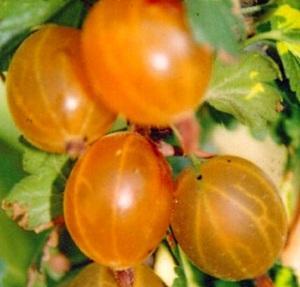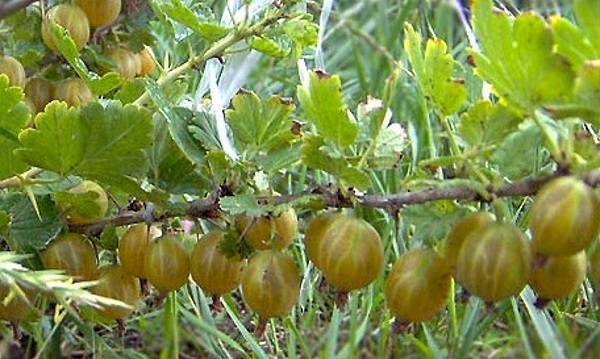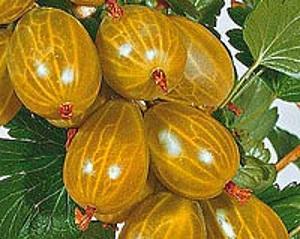Planting a Russian yellow gooseberry variety at a summer cottage and caring for it
 A lot is written about the benefits of gooseberries in the scientific literature, but for some reason only in the last decade they started talking about its properties and qualities, as about some kind of discovery.
A lot is written about the benefits of gooseberries in the scientific literature, but for some reason only in the last decade they started talking about its properties and qualities, as about some kind of discovery.
Gooseberry is an irreplaceable source of vitamin C, it perfectly removes radionuclides from the body, helps to restore a full-fledged digestive process, having a beneficial effect on intestinal motility, and this is not all the advantages of this sweet and sour berry.
Therefore, in almost every personal plot today you can find many varieties of gooseberries ... But often, all the same, modern summer residents-gardeners give preference to high-yielding gooseberry species.
Many gardeners are already familiar with such a mid-late gooseberry variety as Russian yellow, attractive for its golden ripe and very tasty berries.
Gooseberry Russian yellow is a fruit shrub with the highest number of positive reviews.
Detail about gooseberry Russian yellow
Gooseberry Russian yellow bred by breeders of the All-Russian Research Institute of Horticulture. Michurina I.V. by cloning, using biological material of several types of varieties of fruit shrubs, in particular Kareless, Shtambovy, Oregon, Curry.

Description of the gooseberry variety Russian yellow:
- features of the bushes - medium-sized, spreading, formed crown of a bush of medium density, young shoots of the variety are thick, light green in color, do not form pubescence of the bush, perennial branches have a light brown color, there is a slight presence of single thorns of medium length, located in the root ground zone of the bush;
- foliage - medium-sized bright green with a slightly shiny waxy coating, does not create pubescence of the bushes;
- inflorescences are pale, of medium size; form an excellent ovary due to self-pollination;
 fruits - berries of large size, oval or pear-shaped, have a dark yellow (golden) color with a waxy tint; sweet and sour with juicy pulp, often used to make jams, preserves, jellies;
fruits - berries of large size, oval or pear-shaped, have a dark yellow (golden) color with a waxy tint; sweet and sour with juicy pulp, often used to make jams, preserves, jellies;- yield indicator - from four kilograms per bush; fruit shedding is not characteristic;
- degree of resistance to diseases - medium, powdery mildew resistant;
- resistance to natural and climatic conditions - intended for cultivation in areas with changeable harsh climatic conditions, winter hardy.
The main advantages of the Russian yellow gooseberry variety are high yield, cold tolerance, excellent quality fruits, which have the property of long fresh storage.
The main disadvantages include the spreading of the bush, which requires a constant tie of branches or the construction of special branch holders, especially during the fruiting period.
Correct fit
The Russian yellow variety gives an excellent harvest for ten to seventeen years after planting. It bears excellent fruit if several of its bushes are planted on the plantation. He loves sunlit areas, does not tolerate excess moisture, but at the same time needs constant watering.

 The distance between the gooseberry bushes should be about two to three meters, taking into account the spreading of the long (one and a half to two meters) and elastic arcuate falling branches.
The distance between the gooseberry bushes should be about two to three meters, taking into account the spreading of the long (one and a half to two meters) and elastic arcuate falling branches.
You can plant the Russian yellow gooseberry variety both in the fall - before the onset of cold weather - late September - early October, and in spring - before bud break.
In the autumn, planting of seedlings is acceptable, and in the spring, summer residents use the seating method using horizontal layers.

Phased planting of seedlings:
- digging holes from forty to seventy centimeters deep;
- application of organic fertilizers mixed with peat and top fertile soil taken when digging holes;
- placing a seedling in a hole with a deepening of the root beginning five to seven centimeters below the previous growth of the plant;
- spreading the roots;
- filling the root system with soil to the level of the earth's horizon;
- soil compaction and watering;
- sprinkling the soil with sawdust mixed with peat.
Correct care
The gooseberry shrub, predisposed to high yields, reveals its fruiting potential only under the condition of constant care for it, which implies timely removal of weeds in the crowns of bushes, hilling the root zone, the necessary watering, the fight against diseases (goblet rust, anthrokoz) and harmful insects (aphids, spider mites ).